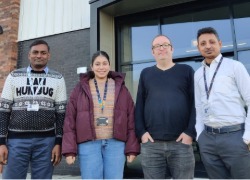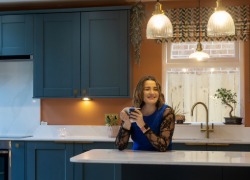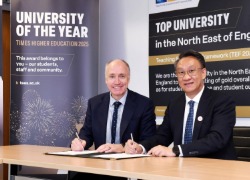Kielder Forest comes to Teesside - Virtually
A Virtual Reality maze is being created by a University of Teesside graduate before the real thing is constructed in the Kielder Forest.
It has been created by Andrew Paterson, who graduated this year from the University’s Computer-Aided Graphical Technology Applications (CAGTA) Masters’ course. Eventually, the real Kielder maze will be built of rock and wire-mesh gabions in the Northumberland forest and become a new tourist attraction.
Andrew, 27, graduated from Glasgow School of Art in 1997 and worked in Scotland and Finland as a digital artist before enrolling on Teesside’s internationally acclaimed MSc CAGTA course because it provided an introduction to Virtual Reality and 3D computerised graphics. He returned to Teesside to work on the Virtual maze in the University’s VR Centre and worked closely with artist Shona Kitchen and architect Nick Coombe, who were commissioned to create the new artistic feature at Kielder.
He was given financial backing from the University’s head of digital arts and media, Carol Cooke, to complete the VR project. “Making this model and preparing a high-end presentation for the University’s Virtual Reality Hemispherium was quite a challenge. I had to learn how to use the software and the design has been changing as we have gone along,” he said.
The real maze is due to be built at the forest in the Spring. Kielder is renowned for its groundbreaking arts commissions, including the award winning Kielder Belvedere and the Skyspace. Peter Sharpe, curator at Kielder, said the Maze would be sited at the base of Kiedler Castle deep in the heart of the forest.
“Nick Combe and Shona Kitchen won the commission with their innovative ideas for a maze made from gabions filled with dark coloured stone” said Carol Cooke. “They tried out several designs but were unable to fully visualise the finished maze. Then we hit on the idea of a virtual maze, which would allow the design to be easily tweaked if necessary."
Andrew said: “I was delighted to be given the chance to learn more about Virtual Reality modelling and it has proved really helpful to Nick and Shona.”
He is about to start a six-month guest research position with the Fraunhofer Institute in Bonn, Germany dealing with audio-augmented virtual environments.
 Groundbreaking project to unlock nuclear energy's role in
...
Groundbreaking project to unlock nuclear energy's role in
... Start the new year by expanding your knowledge
Start the new year by expanding your knowledge  Teesside University strengthens long-standing partnership
...
Teesside University strengthens long-standing partnership
...